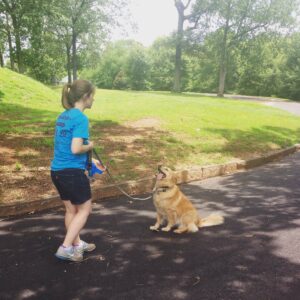How Do Bad Behaviors Form?
Some of the worst dog behaviors seemingly come out of nowhere. I have had many clients explain how their dog was fine for awhile, and then all of sudden, they randomly become wild, poorly behaved, aggressive, etc. I’ve had common stories where owners are scratching their head, wondering why their dog suddenly started attacking their sibling when they got along so well before. Or where a dog was so docile, quiet and sweet, and then transformed into an uncontrollable maniac. Or dogs that might have only shown territorial barking in the past, were now lunging and biting guests that came into the home.
Bad behaviors don’t normally come out of nowhere though. There is always a direct cause and sometimes severe behavior problems are just a culmination of poor habits, unaddressed fear, and lack of leadership and consistency in the dog’s life. Bad behaviors don’t appear randomly like magical wizards…they are created and in some cases, unintentionally reinforced by owners.
 Often times, many people will link their dog’s behavior (especially anxiety or aggression) to a possible past life of abuse or neglect. While this can be attributed to some cases, it doesn’t mean dogs cannot overcome trauma. Sure, there might still be long-lasting or permanent effects from said trauma, but it doesn’t have to be so uncontrollable or severe. Behavior issues can be managed, but they can also be eliminated too!
Often times, many people will link their dog’s behavior (especially anxiety or aggression) to a possible past life of abuse or neglect. While this can be attributed to some cases, it doesn’t mean dogs cannot overcome trauma. Sure, there might still be long-lasting or permanent effects from said trauma, but it doesn’t have to be so uncontrollable or severe. Behavior issues can be managed, but they can also be eliminated too!
While rescue dogs might have a checkered past, I have also worked with many dogs that were bred into a life of love and luxury, and STILL came out with serious behavior issues, including anxiety and aggression! How does one explain these cases when these dogs never experienced severe trauma or gone through an abusive life? Whatever the situation is, be it a breeder dog or rescue dog, they can achieve behavioral balance and success!
With my experience as an Austin dog trainer, bad behaviors can be correlated to anxiety and fear. What causes the anxiety and fear? Typically, it can that the owner has not been consistent with their set boundaries and their overall leadership (sometimes allowing the dog to rule, and then punishing the dog when they get tired of it). Also, the lack of confidence and fear is sometimes reinforced when there’s no leadership or anyone trying to to direct them through gradual exposure and desensitization of the triggers. Communication is the key though, and it is important to be consistent with that communications to prevent or eliminate bad behaviors. Dogs needs to understand what we expect of them and what we do not want them to do. Through guidance, the dog can be more at ease, understand what he/she needs to do, and learn how to not only be a behaved dog, but a happy, balanced dog also!
So next time you see a misbehaved dog and think it is probably because it once abused, consider that there might more underlying factors present. Maybe there’s just a weak relationship where the dog is unsure of himself and the role his owner is playing in his life. Maybe the dog is allowed to be a nutter because the owner has not communicated otherwise. Given the opportunity, even with the sweetest dog in the world, a dog that is allowed to do what they want all the time could take their free will to inappropriate levels where even aggression or severe anxiety is involved. Don’t hurt your dog this way, or the relationship between you two…strengthen it with clear communication, set boundaries, and situations where everyone is set up for reward and success!
If your dog needs some in-home training for either mild or severe behavior issues, call me at 800-649-7297!
